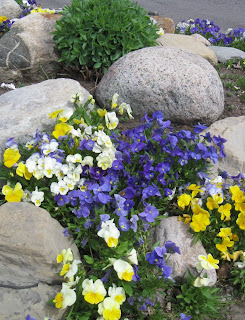Everyone talks about the Butchart Gardens in Victoria. It’s a huge tourist attraction and for sure very profitable at an admission fee of $33.10 + 15% tax. It attracts a massive stream of visitors, buses full of tourists, huge parking lots.
And even as a senior, arriving 45 minutes before they close in the afternoon, full admission is demanded, no half-day pass or senior discount...
.
.
The Horticulture Centre of the Pacific (HPC)
However, there is a hidden gem among the West Coast public gardens that is visited mostly by garden professionals and locals. For just $5, you can enter this magical horticultural gem any day except during Christmas time (Dec 18 - Jan 6).
HCP is located in Saanich, a north-west suburb of Victoria, British Columbia - not too far from the Butchart Gardens. The Horticulture Centre of the Pacific (HCP) is all about plants - period. It doesn’t boast a luxurious restaurant, gift shop or multi-media visitor center and is void of ten-thousands of visitors per day.
.
Lose yourself among its 40 hectares, 2.4 of which are divided into 24 demonstration and teaching gardens showing more than 10,000 varieties of plants:
Bees, Birds and Butterflies Garden
Children's Garden
Dahlia Trial Garden
Doris Page Winter Garden
Drought Tolerant Garden
Ground cover Garden
Hardy Fuchsia Garden
Heather Garden
Herb Garden
Lily Garden
.
.
Mixed Perennial Beds & Mixed Borders
Native Plant Demonstration Garden
Native Plant Restoration Area
An Orchard
Ornamental Grass Garden
Rhododendron and a Hosta Garden
Rose Garden
Takata Garden
Vegetable Garden
Water Feature Garden
Woodland Garden
.
.
A graceful bridge in the cool green refuge, spans the Takata Japanese garden, with ferns, irises and ornamental grasses providing a foliage counterpoint. A 12-by-18-meter Zen Garden will be added soon.
.
The garden design staff here is small, but an army of students help to maintain the gardens, part of the HCP's 10-month-long accredited diploma course in landscape maintenance. Did I mention the warm and cozy coffee-shop with its patio, the library or the lovely gift shop?
Horticulture Centre of the Pacific
505 Quayle Rd. Victoria,
British Columbia V8X 3X1
http://hcp.ca/gardens_hcp/
.http://hcp.ca/gardens_hcp/
.
Dogs on leashes are permitted.
.
.
Another Hidden Gem for Plant Lovers in Victoria, BC
…and a beautiful oasis on the edge of University of Victoria’s campus:
Discover UVic's Finnerty Woodland Gardens, a space for students, staff, faculty and the community to reflect and be inspired. Get their self-guided walking tour as a pdf from their website and watch a short video.
Discover Also Two Unique Trees:
Camellia:
A long-lived broadleaf evergreen shrub, growing everywhere on Vancouver Island. Flowers, from bright white to deep red, come in 6 forms: single, semi-double, double rose, anemone, peony and formal double. Here they do best with some protection from cold winds and partial or light shade.
Liquidambar (Sweet Gum):
A late spring foliage tree, it is one of the finest trees for long-lasting and consistently brilliant fall color. Liquidambar is an attractive, versatile tree - hardiness zones 5 to 9 in full sun - with maple-like foliage. Liquidambar does require additional moisture during prolonged summer dry spells. Speaking of Maple tree leaves: On Vancouver Island, they are as large as dinner plates!
Finnerty Gardens is free and open to the public year-round. It is located north of Cedar Hill Cross Road and west of Henderson Road. Look out for busses to the UVic - or if drive, the Parking lot #6 is closest to Finnerty Gardens. The entrance to the gardens is near the Interfaith Chapel, on the south-west edge of the campus. A great time to visit is during the Rhododendron bloom.
Whether you're a bird watcher, gardener, botanist or just seeking a
lovely place to walk, these quiet gardens are perfect for enjoying nature.
.





































